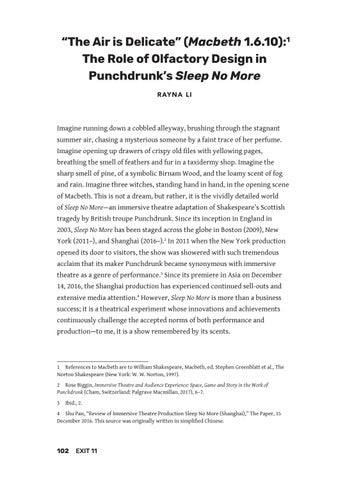“The Air is Delicate” (Macbeth 1.6.10):1 The Role of Olfactory Design in Punchdrunk’s Sleep No More R AY NA L I
Imagine running down a cobbled alleyway, brushing through the stagnant summer air, chasing a mysterious someone by a faint trace of her perfume. Imagine opening up drawers of crispy old files with yellowing pages, breathing the smell of feathers and fur in a taxidermy shop. Imagine the sharp smell of pine, of a symbolic Birnam Wood, and the loamy scent of fog and rain. Imagine three witches, standing hand in hand, in the opening scene of Macbeth. This is not a dream, but rather, it is the vividly detailed world of Sleep No More—an immersive theatre adaptation of Shakespeare’s Scottish tragedy by British troupe Punchdrunk. Since its inception in England in 2003, Sleep No More has been staged across the globe in Boston (2009), New York (2011–), and Shanghai (2016–).2 In 2011 when the New York production opened its door to visitors, the show was showered with such tremendous acclaim that its maker Punchdrunk became synonymous with immersive theatre as a genre of performance.3 Since its premiere in Asia on December 14, 2016, the Shanghai production has experienced continued sell-outs and extensive media attention.4 However, Sleep No More is more than a business success; it is a theatrical experiment whose innovations and achievements continuously challenge the accepted norms of both performance and production—to me, it is a show remembered by its scents.
1 References to Macbeth are to William Shakespeare, Macbeth, ed. Stephen Greenblatt et al., The Norton Shakespeare (New York: W. W. Norton, 1997). 2 Rose Biggin, Immersive Theatre and Audience Experience: Space, Game and Story in the Work of Punchdrunk (Cham, Switzerland: Palgrave Macmillan, 2017), 6–7. 3 Ibid., 2. 4 Shu Pan, “Review of Immersive Theatre Production Sleep No More (Shanghai),” The Paper, 15 December 2016. This source was originally written in simplified Chinese.
102
EXIT 11
